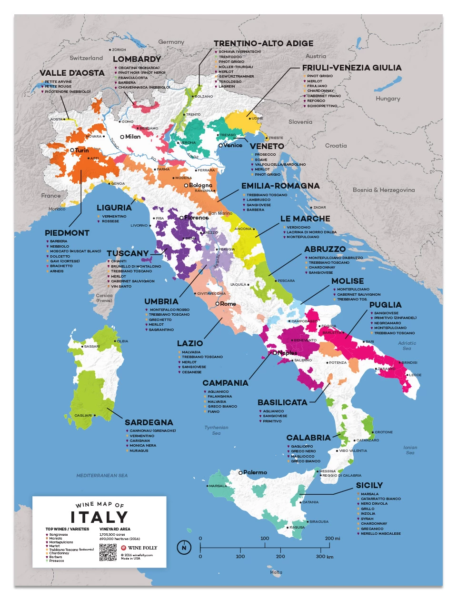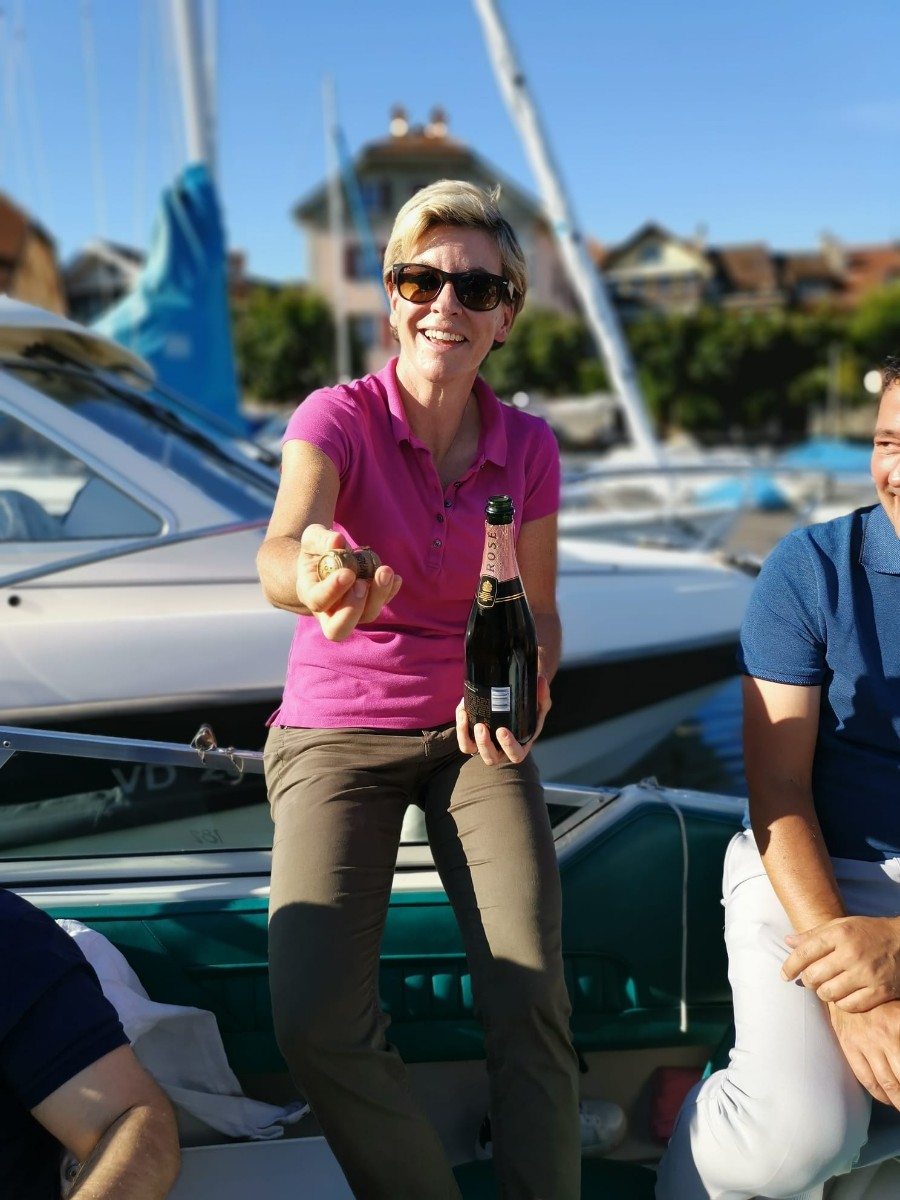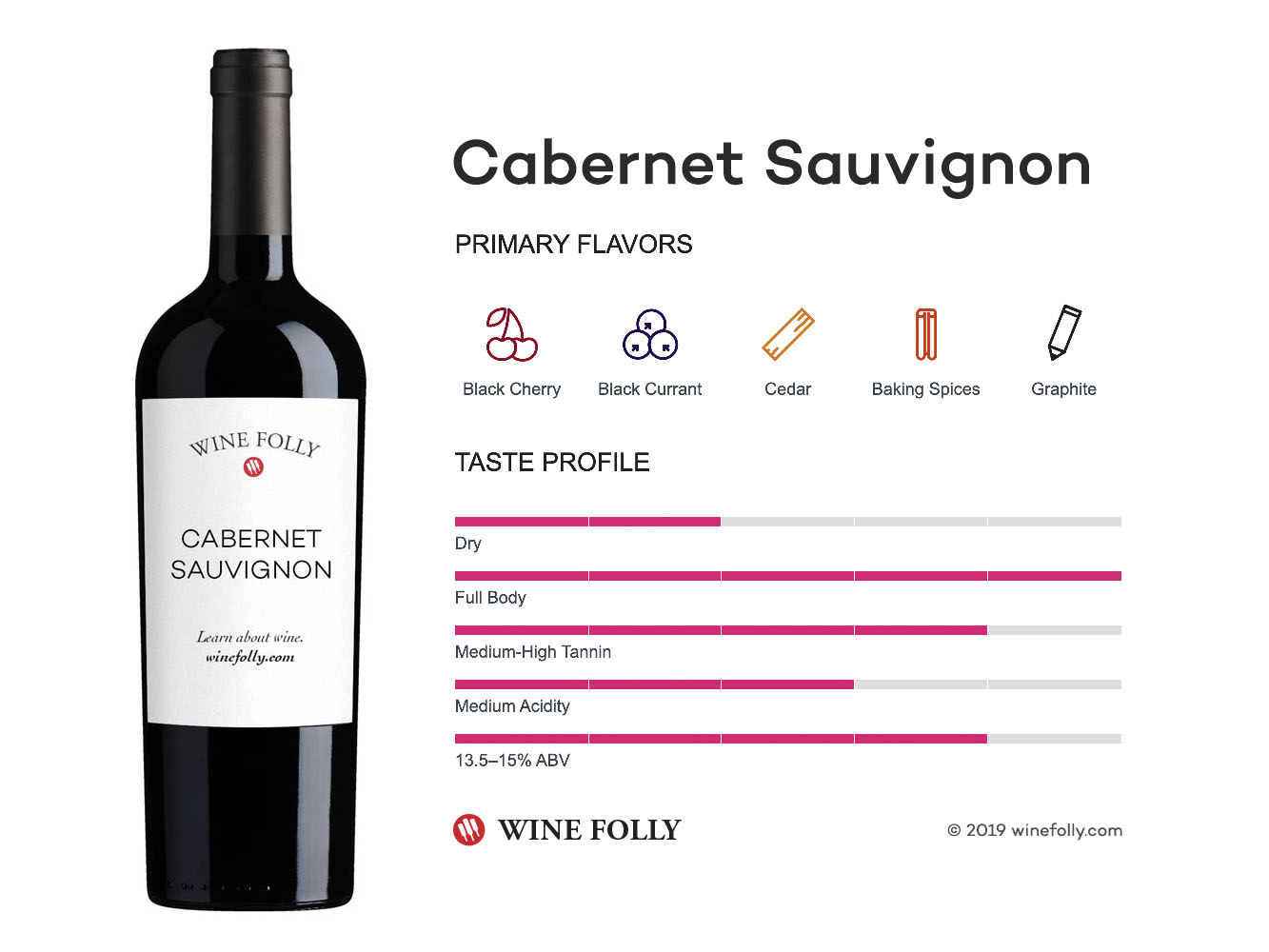Nebbiolo (red/Piemonte):
The most exalted red wine variety of Piedmont is Nebbiolo. This wine is striking to experience because its delicate, pale, brick-red color and floral cherry and rose aromas are completely contrasted by somewhat aggressive, chewy tannins. Because of its structure, you’ll find that Nebbiolo wines are a favorite for wine collectors who will happily set aside wines to open them decades later to reveal a delightfully soft and delicate wine. Even though Nebbiolo has a reputation for tannins and long-term aging, many of the sub-regions (Langhe, Alba, etc.) produce softer styles with a similar weight to whole-cluster Pinot Noir.
Barolo DOCG (100%)
The color is pale garnet, which doesn’t really give you any clue of the intensity in this wine. Its rigid tannins, bold flavors, and higher alcohol (usually around 14% ABV) are more like something you’d find in Bordeaux. Barolo is actually the fruitiest and most full-bodied of all the Nebbiolo regions in Northern Italy. Expect flavors of raspberry, red cherry, roses, potpourri, cocoa, anise, licorice, allspice, truffles, and a clay lick (Tar & Roses).
Barolo wines age at least 18 months in the barrel, with a total of three years aging before release. Even though that sounds like a lot, this wine is really meant to age. Most traditionally-made examples only start to come around at 10+ years (when all the tannins chill out). Riserva Wines labeled Barolo “Riserva” are aged for a minimum of five years.
There are eleven different communes of Barolo, with two different main taste styles (based on the soil type: limestone vs. sandstone). The lighter-tasting wine communes include La Morra and Barolo, with limestone-based soils. The bolder-tasting wine communes include Serralunga d’Alba, Monforte d’Alba, and Castiglione Falletto, with more weathered sandstone-clay soils.
Barbaresco DOCG (100%)
The mostly fertile limestone-based soils in Barbaresco (along with its slightly milder climate) results in wines with noticeably less tannins than Barolo. That’s not to say Barbaresco isn’t tannic; it’s still a monster! It’s just a nicer, friendlier sort of beast.
In terms of flavors, Barbaresco delivers amazing red fruit. Aromas of strawberry, raspberry, cherry syrup, and cotton candy all mingle together on top of roses, potpourri, and lighter notes of anise. It’s not quite as “tarry.” Barbaresco must age 26 months (~2 years), with at least 9 months in the barrel. Barbaresco Riserva must age 50 months (~4 years), with about 24 months in the barrel.
Roero DOCG (95% min)
Roero also sits within Alba in Piedmont right in-between Barolo and Barbaresco. This wine continues to fly under the radar even though it was recently elevated to DOCG status in 2004. Nebbiolo wines are every bit as intense and structured as Barolo (but usually at a fraction of the price). They also have Barbaresco’s sweet fruit. Roero Riserva requires at least of 32 months of aging, including six months in the barrel.
Nebbiolo d’Alba (100%)
Langhe Nebbiolo DOC (85% min.)
Piemonte Nebbiolo DOC (85% min.)
Barbera (red/Piemonte):
Barbera is the most planted variety in Piedmont and it’s what you’ll often find the locals drinking. Great wines of Barbera deliver aromas of red and black fruit (particularly raspberries, lingonberries, and blackberries), along with espresso, smoke, and fresh anise, supported by velvety tannins and a spicy finish. The wines are often oaked to deliver richer, opulent fruit flavors, but most everyday Barberas are medium-bodied with a touch of spicy-earthy terroir. Despite the prevalence of this grape in the region, Barbera continually flies under the radar and usually offers good economic value. Here are the regions that specialize in Barbera:
Barbera d’Asti DOCG (90% min)
Barbera del Monferrato Superiore DOCG
Barbera del Monferrato DOC
Barbera d’Alba DOC
Corvina (red/Veneto):
Corvina is the most important of a blend of 3 grapes (Corvina, Rondinella, and Molinara) used in Valpolicella and Bardolino. Wines offer tart red cherry, cinnamon, carob and green peppercorn flavors.
Amarone della Valpolicella DOCG
Expect bold aromas of cherry liqueur, black fig, carob, cinnamon and plum sauce along with subtle notes of green peppercorn, chocolate and crushed gravel dust. Some Amarone wines should really continue to age for 10 or 15 years longer to develop those keen flavors, so “the older the better” tends to reign true with this particular wine.
To make Amarone wine:
1. pick grapes
2. dry grapes until there is 40% less liquid (called apassimento and can take as long as 120 days)
3. slowly press dried grapes
4. slowly ferment grapes into wine over a period of 35–50 days (this is a long time for wine!)
However, due to modern technology two distinct styles have emerged. There are those who practice the traditional method of naturally drying their grapes and using neutral oak or chestnut barrels to age them and there are those who use a modern method of quickly drying grapes using temperature and humidity-controlled rooms and aging their wines in new oak barrels. Both methods can make excellent tasting wines but they will taste a bit different on first release and also tend to age differently.
Traditional Method
Amarone della Valpolicella made in the traditional method tend to maintain their acidity longer and, thus, will also potentially age quite a bit longer too. These wines also take a bit longer to come around, meaning you’ll want to be sure to hold them for around 20 years to really let the wine shine. It’s common to see producers practicing the traditional technique to only use the regional grapes of Corvina, Corvinone and Rondinella in the blend.
Modern Method
Amarone della Valpolicella made in the modern method tend to be quite a bit bolder upon release because of the help of new oak aging which adds flavors of chocolate, molasses and vanilla along with cherry liqueur. It’s also more common to see non-indigenous varieties blended into the modern-styled wines. Legally, it can be up to 25% of other grapes including Cabernet Sauvignon, Merlot and Sangiovese. The wines taste awesome right out of the gates but aging-wise tend to taper off a bit faster. Some will only last 8–10 years, whereas others with bolder red fruit characteristics will go 20 or so years.
Valpolicella Superiore Ripasso DOC
Ripasso della Valpolicella DOC
After an Amarone wine is created, the leftover grape bits (aka pomace) are strained off and added to Valpolicella Classico. This enables the fermenting wine to have richer flavors and also produce a higher alcohol wine (a higher ABV adds more viscosity). Ripasso della Valpolicella can use the pomace of Recioto della Valpolicella, which is a dessert wine. As you can imagine this style of Ripasso is even more intense!
Recioto della Valpolicella DOCG
Dessert wine! Same grapes as Amarone, same process. But fermentation is
halted before completion to leave residual sugar in the wine. Extremely concentrated, spectacularly complex. Rich dried fruit, lots of tannin and bright acidity. 12% ABV. Can cellar for 20-30 years under proper conditions.
Sangiovese (red/Tuscany, Umbria):
The most planted red wine of Tuscany and all of Italy is famous from the regions of Chianti, Montalcino and Montepulciano in Tuscany. Wines offer raspberry, roasted tomato, and balsamic flavors with an earthy whiff of wet clay. There are many great values to try including Chianti Superiore, Vino Nobile di Montepulciano and Montecucco and Montefalco Rosso and Torgiano from Umbria.
Montepulciano (red/Abruzzo, Marche):
Not to be confused with Vino Nobile di Montepulciano, a Sangiovese wine from Tuscany, Montepulciano is a wine grape that makes medium-bodied red wines with plum, boysenberry and coffee flavors with subtle notes of herbs and crushed black pepper. Most notably look for Montepulciano d’Abruzzo and Rosso Conero.
Aglianico (red/Campania):
A full-bodied red wine with deep savory notes of white pepper, smoke and cured meats that give way to subtle notes of black cherry and spiced plum. Aglianico has high tannins and acidity that make it so the wine improves after a decade of aging. From Campania seek out Aglianico del Taburno.
Primitivo / Zinfandel (Red/Puglia):
If you’re searching for a richer, fuller-bodied red with abundant weight look towards Puglian Primitivo. Primitivo tastes of dark fruit like fresh figs, blueberries and baked blackberries. There’s a distinct dried fruit-leather character to it as well. The word Primitivo doesn’t mean primitive in Italian, but actually means early ripening since these grapes accumulate a lot of sugar early in the season. The early ripening means resulting wines are big, luscious and full of fruit.
Nero d’Avola (red/Sicily):
A bolder red wine variety with fruity flavors of plum, raspberry sauce and licorice with fine tannins with a somewhat smoky, spiced finish. Pairs excellently with rich roasted meats and veggies.




